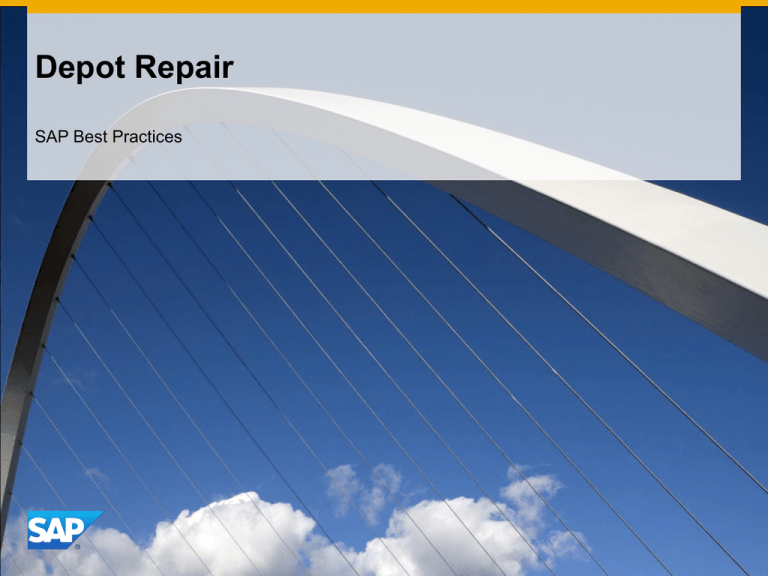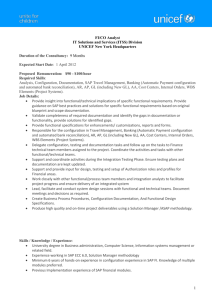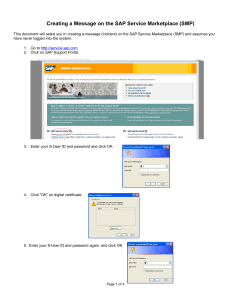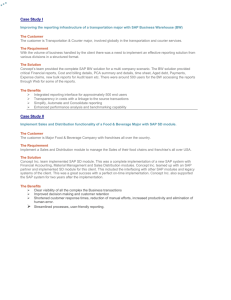
Depot Repair
SAP Best Practices
Purpose, Benefits, and Key Process Steps
Purpose
This scenario covers the processing of a service case from the initial reporting of the
problem by the customer up to billing the customer, when service activities are carried out
at plant.
Benefits
Customer Contract Management
Customer Service and Order Management
Repairs Processing
Inventory Management
Cross-Application Time Sheet
Equipment Handling
Resource-Related Billing
© 2014 SAP SE or an SAP affiliate company. All rights reserved.
2
Purpose, Benefits, and Key Process Steps
Key process flows covered
Create a Customer Contract
Create a Service Notification
Change the Service Notification
Display the Repair Order
Create a Return Delivery with Reference to Sales Order
Stock Overview
Change a Repair Order – Starting Repairs
Display the Service Order
Change the Service Order
Confirm the Materials Used
Posting Goods Issues
Displaying Serviceable Materials
Time Recording (211)
Check Planned/Actual Costs
Close the Service Order Technically
Display Equipment using Equipment List
Display Status of Repair Order
Creating a Billing Request
Create the Billing Document
© 2014 SAP SE or an SAP affiliate company. All rights reserved.
3
Required SAP Applications and Company Roles
Required
Enhancement package 7 for SAP ERP 6.0
Company roles involved in process flows
Service Agent
Sales Administrator
Service Employee
Billing Administrator
Warehouse Clerk
Purchaser
Accounts Receivable Accountant
Enterprise Controller
© 2014 SAP SE or an SAP affiliate company. All rights reserved.
4
Detailed Process Description
Depot Repair
A service agent creates a service notification in the system. The service notification number
is used as a return material authorization (RMA) number in the remainder of the repair
process. The service agent carries out a warranty check on the service notification and
then creates a service contract. The service center informs the customer that they must
send the notebook to the central service center. The service notification number (RMA)
must be specified on the shipping documents; otherwise the notebook is rejected by the
service center. If the necessary spare parts are not in stock, they have to be ordered. A
repair order is then created from the service notification so that the entire repair process
can be controlled and settled. In the repair order, the damaged notebook is automatically
assigned by the returns items created. A service order is automatically generated using an
item proposal to enable the repairs to be carried out. Once the repairs have been carried
out, the costs (for hourly fees and spare parts) are confirmed to the service order. The
repaired notebook is delivered to the customer and the final repair status can be displayed.
The service center creates a billing request. This appears in the repair order as an
additional item and is not a separate document (unlike the billing request in the on-site
service process). Subsequently, the repair order is billed. On a periodic basis the costs and
revenues incurred on the service order are being settled to the repair order, where they can
be evaluated.
© 2014 SAP SE or an SAP affiliate company. All rights reserved.
5
Process Flow Diagram
Customer
Contract
Needs to be
Created
Create
Customer
Contract
Change
Service
Notification
Create Service
Notification
Warehous
e Clerk
Service Event
Agent
Depot Repair
Display
Service Order
Post Goods
Issues
Sales
Purc
Adminis
haser
trator
Create Return
Delivery
Display
Serviceable
Materials
Display Stock
Overview
Display Status
of Repair
Order
Change Repair
Order - Start
Repairs
Change
Service Order
Confirm
Materials Used
Enterprise
Controller
Accounts
Receivable
Accountant
Billing
Administrat
or
Service
Employee
Display Repair
Order
© 2014 SAP SE or an SAP affiliate company. All rights reserved.
Time
Recording
(211)
Check
Planned/
Actual
Costs
Close Service
Order –
Technically
Complete
Display
Equipment
using
Equipment List
Sales:
Period End
Closing
Operations
(203)
Create Billing
Request
Create Billing
Document
Accounts
Receivable
(157)
Period-End
Closing
Service
Orders
(189)
6
Legend
<Function>
Symbol
Description
Usage Comments
Band: Identifies a user role, such as Accounts
Payable Clerk or Sales Representative. This band
can also identify an organization unit or group,
rather than a specific role.
Role band contains
tasks common to that
role.
Symbol
Diagram
Connection
The other process flow symbols in this table go
into these rows. You have as many rows as
required to cover all of the roles in the scenario.
External
to SAP
External Events: Contains events that start or end
the scenario, or influence the course of events in
the scenario.
Business
Activity / Event
SubProcess
Reference
Process
Decision
Flow line (solid): Line indicates the normal sequence
of steps and direction of flow in the scenario.
Flow line (dashed): Line indicates flow to
infrequently-used or conditional tasks in a
scenario. Line can also lead to documents involved
in the process flow.
Connects two tasks in
a scenario process or
a non-step event
Business Activity / Event: Identifies an action that
either leads into or out of the scenario, or an
outside Process that happens during the scenario
Does not correspond
to a task step in the
document
Unit Process: Identifies a task that is covered in a
step-by-step manner in the scenario
Corresponds to a task
step in the document
To next / From last Diagram: Leads
to the next / previous page of the
Diagram
Flow chart continues on the next /
previous page
Hardcopy / Document: Identifies a
printed document, report, or form
Does not correspond to a task
step in a document; instead, it is
used to reflect a document
generated by a task step; this
shape does not have any outgoing
flow lines
Financial Actuals: Indicates a
financial posting document
Does not correspond to a task
step in a document; instead, it is
used to reflect a document
generated by a task step; this
shape does not have any outgoing
flow lines
Budget Planning: Indicates a
budget planning document
Does not correspond to a task
step in a document; instead, it is
used to reflect a document
generated by a task step; this
shape does not have any outgoing
flow lines
Manual Process: Covers a task
that is manually done
Does not generally correspond to
a task step in a document;
instead, it is used to reflect a task
that is manually performed, such
as unloading a truck in the
warehouse, which affects the
process flow.
Existing Version / Data: This block
covers data that feeds in from an
external process
Does not generally correspond to
a task step in a document;
instead, this shape reflects data
coming from an external source;
this step does not have any
incoming flow lines
System Pass / Fail Decision: This
block covers an automatic
decision made by the software
Does not generally correspond to
a task step in the document;
instead it is used to reflect an
automatic decision by the system
that is made after a step has been
executed.
Financial
Actuals
Process Reference: If the scenario references
another scenario in total, put the scenario number
and name here.
Corresponds to a task
step in the document
Sub-Process Reference: If the scenario references
another scenario in part, put the scenario number,
name, and the step numbers from that scenario
here
Corresponds to a task
step in the document
Process Decision: Identifies a decision / branching
point, signifying a choice to be made by the end
user. Lines represent different choices emerging
from different parts of the diamond.
Does not usually
correspond to a task
step in the document;
Reflects a choice to
be made after step
execution
© 2014 SAP SE or an SAP affiliate company. All rights reserved.
Usage Comments
Hardcopy /
Document
Budget
Planning
Unit Process
Process
Reference
Description
Manual
Process
Existing
Version /
Data
System
Pass/Fail
Decision
7
Appendix
Master Data Used
Service Plant
Material/Service
Material
Sold-to party
Ship-to party
Payer
Plant
Storage Location
Company Code
CO Area
Sales organization
Distribution channel
Division
Employee
© 2014 SAP SE or an SAP affiliate company. All rights reserved.
8
© 2014 SAP SE or an SAP affiliate company. All rights reserved.
No part of this publication may be reproduced or transmitted in any form or for any purpose without the express permission of SAP SE or an
SAP affiliate company.
SAP and other SAP products and services mentioned herein as well as their respective logos are trademarks or registered trademarks of SAP SE
(or an SAP affiliate company) in Germany and other countries. Please see http://global12.sap.com/corporate-en/legal/copyright/index.epx for additional
trademark information and notices.
Some software products marketed by SAP SE and its distributors contain proprietary software components of other software vendors.
National product specifications may vary.
These materials are provided by SAP SE or an SAP affiliate company for informational purposes only, without representation or warranty of any kind,
and SAP SE or its affiliated companies shall not be liable for errors or omissions with respect to the materials. The only warranties for SAP SE or
SAP affiliate company products and services are those that are set forth in the express warranty statements accompanying such products and
services, if any. Nothing herein should be construed as constituting an additional warranty.
In particular, SAP SE or its affiliated companies have no obligation to pursue any course of business outlined in this document or any related
presentation, or to develop or release any functionality mentioned therein. This document, or any related presentation, and SAP SE’s or its affiliated
companies’ strategy and possible future developments, products, and/or platform directions and functionality are all subject to change and may be
changed by SAP SE or its affiliated companies at any time for any reason without notice. The information in this document is not a commitment,
promise, or legal obligation to deliver any material, code, or functionality. All forward-looking statements are subject to various risks and uncertainties
that could cause actual results to differ materially from expectations. Readers are cautioned not to place undue reliance on these forward-looking
statements, which speak only as of their dates, and they should not be relied upon in making purchasing decisions.
© 2014 SAP SE or an SAP affiliate company. All rights reserved.
9





